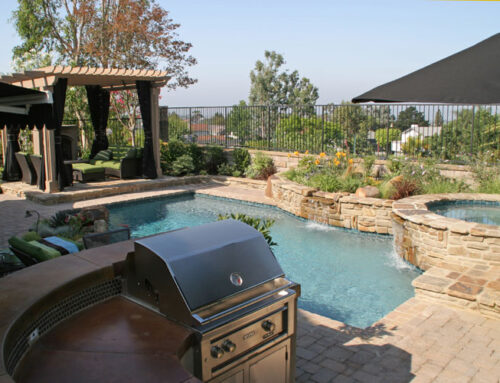Table of Contents
A starry winter night can be positively magical and can get us thinking about how to make our yard more attractive and functional after dark. Landscape lighting is a terrific way to make your outdoor space more welcoming all year long. But there are so many choices. How can you figure out what features to illuminate and what kind of fixtures to use? Working with an experienced landscaping team can help you make the best choices for safety, function and a gorgeous, well-balanced look after dark.
What Are the Benefits of Landscape Lighting?
Putting a spotlight on your landscape’s best features is one of the big upsides of landscape lighting, but the positives go way beyond aesthetics. Here are some of the biggest benefits of landscape lighting:
- Curb appeal: landscape lighting illuminates your home’s best architectural and landscape features and literally puts them in the best possible light.
- You’ll get more use out of your backyard after dark, even as temperatures drop and the days get shorter.
- It’s safer: landscape lighting can help prevent falls and other accidents.
- It boosts security: illuminated exteriors reduce the risk of trespassing and crime.
- It raises property value by creating a safer, more appealing environment.
What Are My Options for Landscape Lighting?
There are so many options for landscape lighting, from brighter lights in the driveway to more gentle and subtle lights that give just the right amount of shine around a garden bed. Your landscape professional can help you choose the perfect lights for your house facade, favorite trees and shrubs, garden beds, walkways and walls. Here are some of our favorite lighting choices:
- Uplights: mounted at ground level and shining upward, uplights are perfect for trees and garden features.
- Downlights: these mini-spotlights mounted on walls or poles to focus light on a specific spot on the ground. They’re great for building facades, walls and walkways.
- Path lights provide illumination along pathways and hardscaping. They’re often elevated on small spikes along the walkway. Path lights are an important safety feature but also look gorgeous and can spotlight low-lying plants.
- Stair lights are another big safety feature that also adds aesthetic appeal. They’re often less noticeable and less bright than pathway lights and can be built into risers or under the tread of the steps.
- Wall lights: recessed lights or sconces on a wall can illuminate a stairwell for safety or elegantly spotlight your home’s exterior or landscape features.
- Well lights are an increasingly popular option. These small, round lights are partially buried and cast an upward light so they can blend into the surroundings while providing beautiful illumination.
Should I Install Hard-Wired Or Solar Landscape Lights?
Solar lights are increasingly popular since they’re easy to install and don’t require electricity. Solar lights create their own power using photovoltaic cells and are perfect for pathways and other areas that get plenty of sunlight. We can also install solar spotlights around trees and other features. But keep in mind that solar lights need hours of exposure to the sun during the day to keep them working at night. And while solar lights don’t blow out like traditional lights, they may lose brightness over time.
Hard-wired lights are best for areas that don’t get a lot of sunlight or areas where you need more brightness like a driveway or deck. Today’s low-voltage electric bulbs offer brightness and energy efficiency, but some areas like driveways may need higher voltage lights. Hard-wired lights also require wiring with buried cables, so be sure to keep that in mind as part of your landscape planning process. Of course, it’s important to make sure your landscaper is licensed for electrical work or that they can provide a qualified professional for the installation of electrical elements.
Landscape Lighting: Plan Ahead for Best Results
It’s easier than ever to get a gorgeous landscape after dark. But with so many options available, it takes planning and research to make the right choices. Working with a professional team can help you plan and execute the best and most elegant solutions. Here are some tips for planning your landscape lighting:
- Go through photos and catalogs and check out real-life landscape lighting set-ups that appeal to you.
- Walk through your landscape during the day and again at night and pick out features that you want to illuminate with both safety and aesthetics in mind.
- Sit down with your landscape professional and brainstorm. Create a sketch and figure out which types of lights will work best in which locations.
- Figure out power supplies and wiring layouts as you make your lighting plan.
- Even if you’re making plans for down the road, get your ideas on paper now; there may be things you can do to help make it easier for your long range plans. For example, if you’re adding a walkway or doing other landscaping, conduit for future lighting can easily be installed to avoid more work later.
Get Started Now With Acer’s Landscape Lighting Experts
At Acer Landscape Services, we get really excited about landscape lighting as it can be completely transformative. You’ll be amazed at how much more time you’ll spend outside–all year round. And winter is the perfect time to make landscape lighting plans. Our team has time to sit down with you, identify needs and goals and make plans to achieve your gorgeous glowing dreams.



